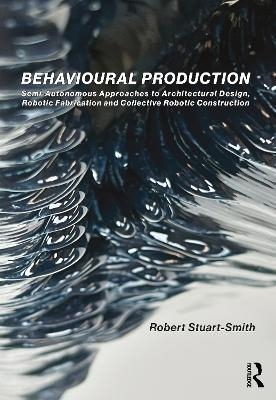
Behavioural Production
Routledge (Verlag)
978-0-367-46342-7 (ISBN)
Autonomous manufacturing and cyber-physical systems are key enabling technologies of the Fourth Industrial Revolution (IR4) which are currently being incorporated into the building design and construction industries. These emerging IR4 technologies have the potential to effectively improve construction affordability and productivity, address current and future building demand, and reduce the environmental impact of the built environment. However, design approaches that make use of IR4 technologies are still relatively unexplored. While automation, such as mass production, promotes standardised design solutions, design thinking that embraces varying degrees of autonomy can lead to unique and considered approaches to design on an industrial scale.
Behavioural Production: Semi-Autonomous Approaches to Architectural Design, Robotic Fabrication and Collective Robotic Construction explores design operating through the orchestration of spatiotemporal events. A multi-agent behaviour-based approach to computation is employed in architectural design and extended to individual and swarm-based robotic methods for additive manufacturing. Behavioural Production seeks to expand our capacity to engage with the world at large through varying degrees of autonomy. In an industrialised world where traditional craftsmanship has been marginalised and cannot scale to meet societal needs, this book speculates a means to bring scalable forms of creativity into the act of making. This is explored through the use of materials, generative algorithms, computer vision, machine learning, and robot systems as active agents in design conception and realisation. The book presents a collection of ideas, projects, and methods developed in the author’s design practices and research labs in the fields of architecture and computer science. This body of work demonstrates that engaging with semi-autonomous processes does not diminish authorship, but rather expands it into new forms of design agency that seamlessly integrate with emerging manufacturing and construction technologies whilst authoring distinctive design character.
Robert Stuart-Smith is the Director of the Masters of Science in Design: Robotics and Autonomous Systems program (MSD-RAS), Assistant Professor of Architecture, and Affiliate Faculty in Engineering’s GRASP Lab at the University of Pennsylvania. He leads the Autonomous Manufacturing Lab in Penn’s Department of Architecture and University College London’s Department of Computer Science, managing over $5 million in government-funded research and collaborating with industry partners such as Cemex, Skanska, Mace, Burohappold, Arup, MTC, and Ultimaker. Stuart-Smith’s research intersects design, computation, robotic fabrication, and collective robotic construction. His multidisciplinary Aerial Additive Manufacturing research, published in Nature, demonstrates the world’s first in-flight additive manufacturing by cooperating drones. Integrating robotic manufacturing with architectural design, Stuart-Smith aims to address the environmental and economic costs of design and production while enhancing their cultural and aesthetic impacts. He co-directs Robert Stuart-Smith Design and co-founded Kokkugia in 2004, following his tenure at Arup, Grimshaw, and Lab Architecture Studio, where he contributed to 1.6 million SqFt and $1.7 billion of built work. Stuart-Smith has published in journals including Nature, Science Robotics, AD Architectural Design, and Architecture D’Aujourd’hui. His work is part of the permanent collection at Frac Centre-Val de Loire and has been exhibited at the Venice, Tallinn, Beijing and Prague Architecture Biennales, and Paris Lieu de Design. He has taught at AA, WashU, RMIT, and U.Innsbruck, and lectured at institutions including ETHZ, U.Stuttgart, MIT, CCA, Sci-Arc, AA, UCL Bartlett, RMIT, Angewandte, Strelka Institute, and Tsinghua University. His work has been featured by BBC Click, New Scientist, Smithsonian, Architizer, France 3, and others.
1. Autonomy: Orchestrating and Partnering with External Phenomena 2. Architecture and Autonomous Construction: Industry 4.0 and Robotic Building Technology 3. Generative Production: The Agency of Things 4. Autonomous Agents: Encoding Design Intent within 3D Graphical Space 5. Structural Agency: Encoding Structural Design within Formative Processes 6. Additively Manufactured Architecture: Form, Topology and Material organisation 7. Autonomous Perception: Leveraging Computer Vision and Machine Learning in Design 8. Adaptive Manufacturing: Towards Situated, Embodied Production 9. Aerial Additive Manufacturing: Explorations into Collective Robotic Construction 10. Behavioural Production: A vision for Autonomous Design, Manufacturing and Construction
| Erscheinungsdatum | 23.08.2024 |
|---|---|
| Zusatzinfo | 201 Halftones, color; 201 Illustrations, color |
| Verlagsort | London |
| Sprache | englisch |
| Maße | 178 x 254 mm |
| Gewicht | 798 g |
| Themenwelt | Informatik ► Theorie / Studium ► Künstliche Intelligenz / Robotik |
| Naturwissenschaften ► Biologie ► Ökologie / Naturschutz | |
| Technik ► Architektur | |
| Technik ► Umwelttechnik / Biotechnologie | |
| ISBN-10 | 0-367-46342-3 / 0367463423 |
| ISBN-13 | 978-0-367-46342-7 / 9780367463427 |
| Zustand | Neuware |
| Informationen gemäß Produktsicherheitsverordnung (GPSR) | |
| Haben Sie eine Frage zum Produkt? |
aus dem Bereich


